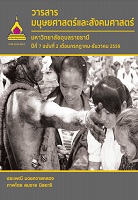การคลี่คลายประวัติศาสตร์บาดแผลและความเป็นชายขอบของชุมชนคาทอลิกอีสาน : กรณีศึกษาหมู่บ้านสองคอน จังหวัดมุกดาหาร
Main Article Content
บทคัดย่อ
บทความนี้มีวัตถุประสงค์เพื่อศึกษารูปแบบการคลี่คลายปัญหาความขัดแย้งระหว่างรัฐกับกลุ่มคนคริสต์ นิกายโรมันคาทอลิก บ้านสองคอน และศึกษาวิธีการก้าวผ่านความเป็นชายขอบของกลุ่มคนคริสต์นิกายโรมันคาทอลิกในชุมชนอีสาน โดยใช้กระบวนการศึกษาแบบบูรณาการจากการรวบรวมข้อมูลจากเอกสาร สังเกตการณ์ และสัมภาษณ์บุคคลที่เกี่ยวข้อง เลือกกลุ่มตัวอย่างแบบเฉพาะเจาะจง และนำผลมาวิเคราะห์และอธิบายตามแนวคิดทางสังคมวิทยาและมนุษยวิทยา
จากการศึกษาในครั้งนี้พบว่ามูลเหตุและกระบวนการกลายเป็นคนชายขอบของคนคริสต์บ้านสองคอนเกิดจากปัจจัยของการถูกขับออกจากชุมชนเดิม เนื่องจากถูกกล่าวหาว่าเป็นปอบ การหลบหนีการเกณฑ์แรงงานและทาส และเป็นผู้หลบหนีคดีความของรัฐ กลุ่มคนเหล่านี้ได้หลอมรวมกันเป็นชุมชนโดยมีวัดคาทอลิกเป็นศูนย์กลางจนเป็นที่รับรู้ใน อัตลักษณ์ในชื่อที่ถูกเรียกว่า คนคริสต์บ้านสองคอน การเป็นชายขอบในระยะที่สอง คือ ยุค จอมพล ป.พิบูลสงคราม ที่มีการใช้นโยบายผสมกลมกลืนและการส่งเสริมความเป็นชาติไทย โดยกำหนดให้ศาสนาพุทธเป็นศาสนาประจำชาติ จึงมีประเด็นความต่างทางศาสนา รัฐไทย กล่าวหาชุมชนชาวคริสต์บ้านสองคอนฝักใฝ่กับฝรั่งเศสช่วงเข้ามาล่าอาณานิคมชุมชนชาวคริสต์บ้านสองคอนถูกรังเกียจ จนกลายเป็นคนชายขอบของรัฐไทย จากนโยบายการผสมกลมกลืนของรัฐไทย มีการส่งเจ้าหน้าที่ตำรวจเข้ามาเกลี้ยกล่อมให้ชาวบ้านเปลี่ยนมานับถือ ศาสนาพุทธแต่ไม่สำเร็จ และส่งผลกระทบต่อคนที่ขัดขืนนโยบายโดยการฆ่าครูสอนศาสนา การสังหารหมู่เด็กและผู้หญิง นับเป็นประวัติศาสตร์บาดแผลของคนคริสต์บ้านสองคอน ส่วนการคลี่คลายประวัติศาสตร์และกระบวนการสร้างพื้นที่ทางสังคมเพื่อก้าวผ่านความเป็นชายขอบ พบว่ามี 2 รูปแบบ คือ 1) ปฏิบัติการผ่านเรื่องเล่า เพื่อคลี่คลายปัญหาความขัดแย้งที่เป็นประวัติศาสตร์บาดแผล และปฏิบัติการทางสังคม วัฒนธรรมต่าง ๆ ขึ้นมาทดแทนปฏิบัติการแบบเดิม ที่อาจจะทำให้เกิดปัญหาด้านความรู้สึก ความเข้าใจในทางลบ จึงเกิดการสร้างนิยามใหม่เพื่อทำให้คนนอกเข้าถึง เห็นความสำคัญและมีส่วนร่วมในพิธีกรรม เพื่อย้ำความศักดิ์สิทธิ์ ความสำคัญของกลุ่มคนและศาสนา 2) การก้าวผ่านความเป็นชายขอบโดยใช้วิธี การผสมผสานทางวัฒนธรรม ประยุกต์พิธีกรรมและความเชื่อ ให้สอดคล้องกับชุมชนรอบ ข้างที่เป็นคนชาติพันธุ์ลาว มีรากเหง้าวัฒนธรรมล้านช้าง รวมทั้งปรับให้เข้ากับบริบทของความเป็นไทย ที่มีความเชื่อหลากหลาย เพื่อให้คนทุกศาสนาสามารถเข้าร่วมกิจกรรมและพิธีกรรมที่จัดขึ้น
Unravelling the Marginalized and Wounded History of Catholic Communities in Isan: Case Study of Ban Songkhon Village in Mukdahan Province
This case study of Ban Songkhon in Mukdahan aimed to investigate the pattern of Catholic Christian community identities in Isan, the pattern of conflictdisentanglement between the Thai government and Catholic Christianstrategies to escape the marginalization of the Catholic Christian community in Isan, and to identify the strategies of Ban Songkhon Catholicsin regard to this marginalization. Data were collected by a combination of multi-disciplinary methods, including observations, interviews, and analytical and synthesized data. By the application of sociological and anthro-political concepts and frameworks, it was found that for the first period, various factors and processes were used to marginalize the Catholic Christian community identities of Ban Songkhon, such as exclusion based on accusations of being a kind of ghost and avoiding military training, labor,and/or slavery, and having a criminal record. The unwanted individuals connected with each other by participation in Catholic Christian religious practices, and the Catholic Church became the center of the community. The second period of being a marginalized community was during the time of Prime Minister Phibunsongkhram, characterized by Thainationalistic and assimilation policies. Local police unsuccessfully attempted to convert the Catholic community, and many missionaries and children were killed due to opposition to these national policies. The community attempted to unravel its history and social scape of marginalization by the use of two strategies. The first was a construction of an identity through story-tellingand redefining some vocabulary involving rituals and ceremonies, to avoid any misunderstandings or misconceptions, to recruit people and emphasize the importance of religion.The second was the application of rituals and beliefs of neighboring cultures, such as Lao and the Lanxang kingdom, adaptation to the Thai context, and the acceptance of other beliefs and traditions within the community.
Article Details
บทความที่ได้รับการตีพิมพ์เป็นลิขสิทธิ์ของวารสารมนุษยศาสตร์และสังคมศาสตร์ มหาวิทยาลัยอุบลราชธานี
ข้อความที่ปรากฏในบทความแต่ละเรื่องในวารสารวิชาการเล่มนี้เป็นความคิดเห็นส่วนตัวของผู้เขียนแต่ละท่านไม่เกี่ยวข้องกับมหาวิทยาลัยอุบลราชธานี และคณาจารย์ท่านอื่นๆในมหาวิทยาลัยฯ แต่อย่างใด ความรับผิดชอบองค์ประกอบทั้งหมดของบทความแต่ละเรื่องเป็นของผู้เขียนแต่ละท่าน หากมีความผิดพลาดใดๆ ผู้เขียนแต่ละท่านจะรับผิดชอบบทความของตนเองแต่ผู้เดียว

